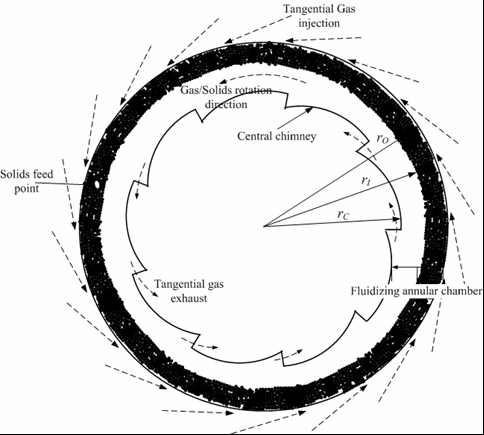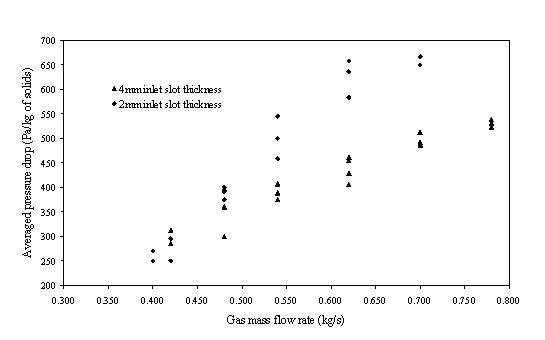522f Experimental Investigation of a Rotating Fluidized Bed in a Static Geometry
The first experimental results obtained with a flexible cold-flow set-up aiming at the validation and the presentation of a novel reactor concept, the Rotating Fluidized Bed reactor in a static geometry (RFB-SG) [1] are presented. The rotational motion of a bed of fluidized particles is realized by feeding the fluidizing gas tangentially via several inlets situated on the circumference of the circumferential reactor. The fluidizing gas is discharged via a centrally located chimney. The presence of a central chimney reduces the fluidizing chamber of the reactor to an annular ring with a given thickness (Figure 1). In a conventional stable fluidized bed, the drag force is balanced by the gravity, whereas, in the RFB-SG, the former is balanced by the centrifugal force. Compared to the conventional Fluidized Bed Reactors (FBR), this set-up is expected to operate more efficiently for high-throughput as well as short residence time operations.
The experimental set-up constructed to perform an analysis of this novel reactor concept has a maximum of 36 gas injection slots, positioned under a 10O angle at an outer diameter of 540 mm. The width of the fluidizing annular chamber of the reactor is fixed at 100 mm. The side walls of the complete reactor are made of thick Plexiglas to visualize the flow behavior in the reactor. The number of inlet slots can be varied evenly from 0 to 36, while each inlet slot thickness can be varied from 0 to 7 mm. Different types of central chimneys with varying outer diameters, of gas exhaust slots and of variable gas exhaust slot thicknesses, can be implemented. Decreasing or increasing the central chimney outer diameter, increases or decreases the fluidizing annular chamber thickness. The fluidizing annular chamber of the experimental set-up can be mounted either vertically or horizontally, to take into account the effects of gravity. Pressure measurements to monitor the pressure variation due to the solids particle bed content are carried out by means of non-intrusive pressure probes located at several positions in the fluidizing annular chamber. They are connected to pressure sensors. A high speed camera is used to monitor the solids particle velocities and the solids particle bed height.
Experiments are performed with variable air mass flow rate (fluidizing gas) and solids particle flow rate at fixed geometrical conditions. Two different types of solids particles (Geldart classification: Type-B, D) are studied. The obtained experimental results show a stable rotating solids bed, with an optimum solids content, without slugging or channeling effects. A sharp inter-phase at the solids particle and freeboard in the fluidizing annular chamber is observed. A vertically positioned reactor shows a difference in the solids bed height at the top-most and the bottom-most position of the fluidizing annular chamber at lower gas mass flow rates, caused by the influence of gravity. Upon increasing the gas mass flow rate, the rotating solids particle bed height tends to be equal in both positions. Furthermore, as the fluidizing gas mass flow rate is increased, an increase in the pressure drop over the solids bed is observed (Figure 2). The pressure drop over the rotating solids bed is observed to be proportional to the square of the gas mass flow rate. Based on the theoretical prediction of the pressure drop due to rotating solids bed and the prediction of the experimentally measured values, a “nearly packed” rotating solids bed is predicted. A detailed comparative analysis of the rotating solids particle velocity and the rotating solids bed thickness as a function of various geometrical conditions and solids particle properties is performed.
Reference:
[1] De Wilde J, Wautier L, Marin G, Heynderickx G, De Broqueville A, A Rotating Fluidized Bed in a static Geometry: Experimental Proof of Concept, FLUIDIZATION XII, Vancouver, B.C., Canada, 13-18 May, 2007 
Figure 1: Fluidizing annular chamber with rotating gas/solids, with an outer radius rO. The central gas discharge chimney with an outer radius of rC. Tangential feeding the gas via gas inlet slots situated at the circumference of a circular reactor. Solids particle feeding directly in the fluidizing chamber

Figure 2: Averaged pressure drop per kg of rotating solids as a function of gas mass flow rate, in the fluidizing annular chamber of 60mm thick and two different tangential gas inlet slot thickness cases